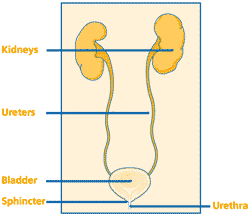How does the urinary system work?
The urinary system consists of the kidneys, the bladder and ureters. The kidneys filter the blood to remove waste products and form urine. The urine flows from the kidneys down through the ureters to the bladder. Another tube called the urethra takes urine from the bladder to the outside.

What are posterior urethral valves?
Posterior urethral valves (or P.U.Valves for short) are a condition found only in boys. It affects the urethra (the tube which runs from the bladder to the outside). In boys with PUV, the urethra has a blockage in it near the bladder. This makes it difficult for the child to pass urine. As the bladder pushes hard to get the urine out, it causes pressure which may result in urine being pushed back from the bladder into the ureters and kidneys. This causes the kidneys and bladder to swell and may lead to kidney damage.
What are the symptoms of PUV?
There are various symptoms associated with PUV, but they may not affect every child in the same way. The degree of blockage affects the severity of the symptoms. Some symptoms include:
- an enlarged bladder, so that it can be felt through the abdomen as a lump
- urinary tract infections (UTIs)
- difficulty in passing urine
- a weak stream of urine, the child passes urine in drops
- unusually frequent urination
- poor weight gain
How is it diagnosed?
PUV can be diagnosed by a routine ultrasound scan during pregnancy if the bladder, ureters or kidneys are swollen. It can also be diagnosed in a newborn baby if the bladder is swollen and urine dribbles constantly. If the blockage was not severe before or just after birth, the condition can remain undetected until the child has symptoms as above.
The severity of the blockage affects how the condition is diagnosed. Each case will be different, but the following tests are usual:
Ultrasound of the abdomen – this is very similar to the ultrasound scan that most women have during pregnancy. It creates a picture of the organs inside your son’s body and shows how well they are working.
Micturating cystourethrogram (MCUG) – this test shows urine passing from the bladder to the urethra and then to the outside. It will also show if the urine is flowing backwards towards the ureters and kidneys (this is known as reflux).
Cystoscopy – this is a scan which uses a small tube with a camera at the end to examine the inside of the bladder.
Blood tests – these will show how well your child’s kidneys are working and check that there is enough fluid inside the body.
Other tests and scans may be needed to check that other parts of the urinary system are working properly. These can include kidney and bladder function tests.
What causes PUV?
It is not inherited in any recognized way and seems to happen in the early stages of pregnancy when the organs, muscle and other tissue starts to form. It is not due to anything you did or ate during pregnancy.
How rare is it and who is affected?
PUV seems to occur in one in every 8000 births and affects only boys.
How can PUV be treated?
There are several options for treatment, depending on how severely the symptoms are affecting your child:
- The first course of action usually deals with the symptoms and includes putting a catheter (thin, plastic tube) into the bladder to drain away the urine. Any UTIs and fluid imbalance will also be treated with antibiotics and intravenous (IV) fluids, which are delivered directly into a vein.
- Next course of action is to try to remove the parts of the valve which are causing the backflow of urine into the kidneys. This is usually carried out using a cystoscope (a tube with a light on the end) rather than a traditional ‘open’ operation.
What is the outlook for children with PUV?
The outlook depends on how much damage has already occurred in the kidneys. This depends upon the blood test results of the child. Children operated for posterior urethral valves will need long term and regular follow up to check that there is no lasting damage to the urinary system following the problem.




